Tom Kaczynski is doing quite well in publishing books from underexposed artists, especially from the generation of artists that came up during the '90s. Reprinting Jon Lewis's early True Swamp comics is an impressive and admirable move in bringing fine work back into the public consciousness, and there's no doubt that Lewis's comics deserve another look. There's much about this collection that shows Lewis as an artist who's just beginning to find his voice and style. Some of the drawing is a bit on the rough side, even after multiple revisions, and there are other details that mark this as the work of an artist who's early in his maturity process. That said, these pages are also crackling with the raw energy of an artist who has just started to tap the wellspring of ideas, one who is enthusiastically bringing his world to life as fast as he can draw it.
This collection of comics originally published in 1994 and 1995 follows the adventures of Lenny the Frog in his swamp. All of the animals and insects in the swamp are intelligent and have needs and dreams not unlike humans, but they are very much still animals and part of a food chain. Indeed, Lenny bemoans nearly being eaten every time he tries to sit still for a moment, think, and philosophize. The obvious touchstone comparison for True Swamp is Walt Kelly's Pogo, and Lewis clearly drew inspiration from Kelly in terms of setting up a particular kind of swamp patois and creating a huge, broad cast of colorful characters. Where Lewis sharply differs is in the way he depicts these characters. This is a raw, nasty world where death is always at hand, yet there are small joys to be experienced every day. Love, sex, friendship, jealousy, knowledge, and religion are all important concerns, but they are experienced in ways unique to each animal. The animals have animal needs—food, survival, and sex (just like humans)—and Lewis enjoys playing up the cruder aspects for humorous effect.
While quotidian details about life in the swamp and the emotional negotiations and struggles of the characters are important, each chapter has both a coherent plot structure as well as the underpinnings of subplot. "Choose Your Poison" introduces us to Lenny, but it also takes us on an adventure as he's captured by a human who thinks he's an entirely new species. In reality, Lenny had hired a marmot friend named Hale to paint a disguise that would fool gators and other predators into ignoring him, but it only served to pique the interest of humans. Lenny manages to accidentally kill his captor by thwipping his tongue up his nose and dislodging part of his brain, an event that brings great angst to the poor frog. He's haunted by the specter of being a murderer for the rest of the book, even if he knows it was kill or be killed.

There's a denseness to Lewis' work that is satisfying as he draws his animals just a touch on the cute side without making them anthropomorphic. The details of everyday life are not spelled out but instead are introduced without explanation, as in the form of currency the animals use (the names of cities), the nature of religion, and the political backbiting that occurs in the swamp. One of the subplots early in the book is that of a human captured by fairies (and tipped off by Lenny) who is enchanted and then traded to a colony of ants for mysterious purposes. In "Blue Caboose", Lenny meets a traveling frog named Twotongue who is a "book"--an animal who seeks specific kinds of knowledge. In this case, it's "killer herps"--reptiles that kill larger animals. Twotongue was looking for the legendary Big Snipper, a herp serial killer, essentially. Upon finding his lair, there was no predator to be found--only a frog and his fungoid friend. The twists and turns of this story were remarkable, with a lot of jaw-dropping and frightening moments to go along with moments of genuine humor.
Further chapters see Lenny confronting a human-sized and -shaped colony of ants, dealing with his crush, and having casual sex with another frog (in this case, it's just fertilizing eggs); Hale having a frank sex talk with another marmot and getting shot down; more animals searching for knowledge; a close encounter with some apparently mystical beings in a bacchanal; and the tragic death of a loved one. Lewis pulls the narrative strings tighter and tighter even as he introduces new characters and new information about the strange world they live in, meting it out in small doses. It doesn't end on a cliffhanger so much as it just ends, as Lewis took a break of several years before he started working on the book again. The next volume will be collected by Uncivilized Books a bit later on; I imagine they'll fold Lewis's recent minicomics in as well. It's a book that focuses on a single character as well as the world he lives in, shifting back and forth between the two and then combining that view for some key sequences.

At its heart, True Swamp is an existential howl. It's as much about the artist's own quest for meaning and purpose as it is for his characters. One can sense Lewis in the person of Lenny the thinker, but also in the person of Hale the inventor and artist. Each character tries to find ways to motivate themselves to explore and engage the outside world, and each finds disappointment in a variety of fashions, both great (being wracked by guilt, being eaten by predators) and small (being shot down by potential mates, losing out on knowledge). One can sense how intuitive the storytelling is because even as the characters interact on a quotidian basis, Lewis reveals small but important details that add richness to their own interactions. On top of that, True Swamp is a world-building exercise that is not dominated by that world-building to the detriment of the stories or characters. Instead, a new aspect of the swamp is revealed in service to the story, like how the denizens drink alcohol or come together to party. Though there are a lot of rough edges here (especially in terms of things like lettering and inking), the bonus material shows just how hard Lewis worked in a short period of time. Indeed, the original version of True Swamp #1 is nearly illegible in comparison to what he would later publish. Seeing that rapid improvement is eye-opening, because it reveals just how important this project was to Lewis. It certainly stands the test of time.







